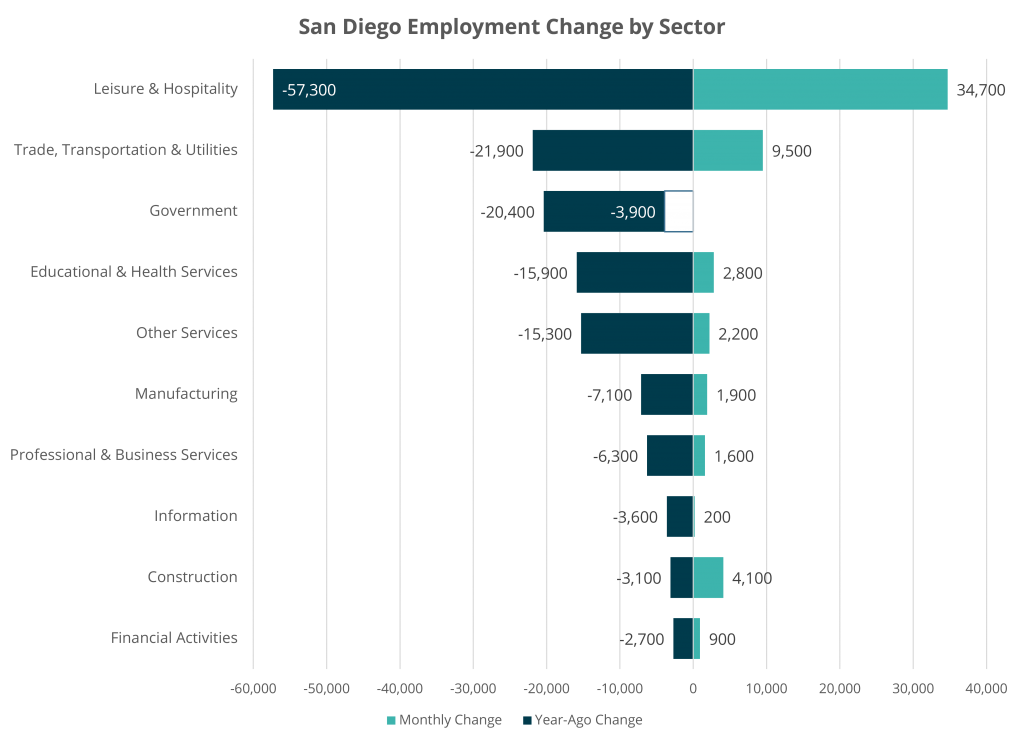Each month the California Employment Development Department (EDD) releases employment data for the prior month. This edition of San Diego’s Economic Pulse covers June 2020 and reflects some effects of the coronavirus pandemic on the labor market. Check out EDC’s research bureau for more data and stats about San Diego’s economy.
Unemployment Slightly Lower
The region’s unemployment rate was 13.9 percent in June down from a revised 15.2 percent in May 2020, and far above the year-ago estimate of 3.3 percent. The region’s unemployment rate remains lower than the state unemployment rate of 15.1 percent, but higher than the national unemployment rate of 11.2 percent during the same time period, respectively. Read more about EDC’s unemployment analysis.
Employment Continues to Recover
Between May 2020 and June 2020, total nonfarm employment in San Diego increased from a revised 1,301,700 to 1,355,700, a gain of 54,000 jobs. EDC’s COVID-19 survey of businesses shows that more than 60 percent of firms surveyed reduced their staff between March and May due to COVID19.The June employment numbers reflect jobs gradually returning to the region. This is consistent with state and national data. In California, nonfarm employment increased by 558,200 in June from the month prior, while payroll employment increased by 4.8 million in the U.S. during the same time period.
Compared to a year ago, San Diego nonfarm employment remains down 153,600 jobs or 10.2 percent. In California, total nonfarm employment is down 1.7 million jobs, or 10 percent compared to a year ago, while the U.S. is down nearly 13 million jobs, or 8.5 percent.
Sector Employment Slowly Returns
The leisure and hospitality industry accounted for the largest monthly gains, adding 34,700 jobs in June, primarily concentrated in food services and drinking places as restaurants reopened. While it is encouraging that the food services and drinking places sector has increased employment the last month, the industry still has 20 percent fewer jobs compared to a year ago. Tourism is still not close to recovered and likely will take much longer, the accommodation industry has 44 percent fewer jobs compared to a year ago.
Trade, transportation, and utilities employment increased this month, adding 9,500 jobs. This was driven primarily by retail, which added 6,800 jobs. Clothing and clothing accessories stores grew by nearly 49 percent in June. This aligns with national retail sales, which jumped 7.5 percent in June. The Census Bureau reported retail sales are 1.1 percent higher than their levels from a year ago, but those gains could be short-lived as infections begin to rise and closures continue.
Construction followed with an additional 4,100 positions, and educational and health services recovered 2,800 jobs lost between April and May. The bulk of job gains in educational and health services came from Ambulatory Health Care Services. The largest monthly employment decline was in government, with a loss of 3,900 jobs, as public finances continue to face revenue challenges.
Looking Ahead
While the employment report reveals solid monthly job gains, San Diego’s economy will likely face more job losses in the coming months. Just last week, the Governor announced more closures to retails and dining in. As industries close again, temporary layoffs are more likely to become permanent and the unemployment rate may rise again. Looking ahead, it is critical that workers have ample access to job training in order accelerate the economy’s recovery.
As educators plan for the upcoming school year, they are faced with unprecedented circumstances. San Diego Unified announced an online only fall learning plan, a first in the region. The lack of on-campus education will not only impact students and children with special needs, but also the working parents that depend on schools and daycare while at work. There are 180,000 households with two working adults and school-aged children. That means there are at least 360,000 workers in our region whose productivity or presence at work is being impacted while the virus remains a threat.

For more COVID-19 recovery resources and information, please visit this page.
EDC is here to help. You can use the button below to request our assistance with finding information, applying to relief programs, and more.
You also might like: